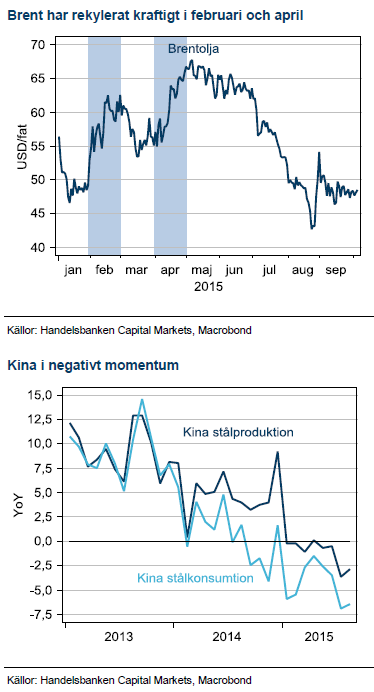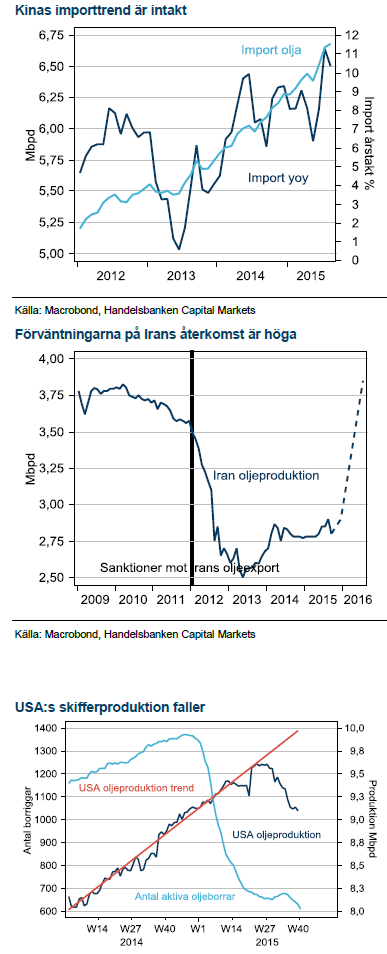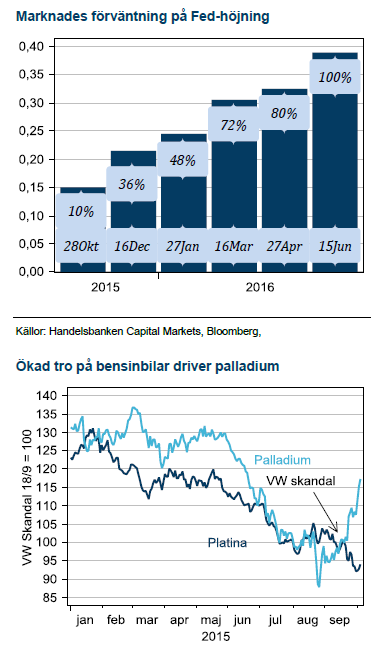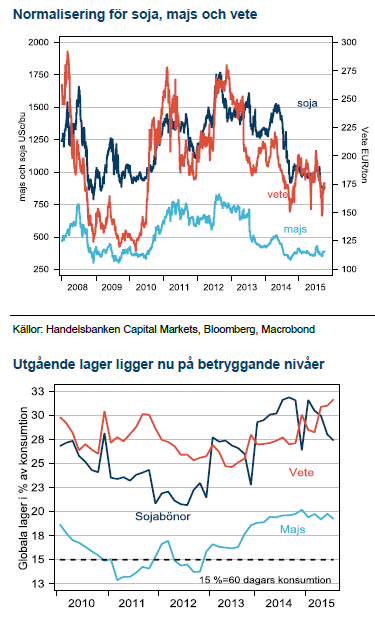Analys
Kvartalsrapport för råvaror

Råvaruplanket – Ännu ingen produktionsrespons
![]() Högre oljepris att vänta
Högre oljepris att vänta
Kina är tillsammans med USA de länder där det lägre oljepriset tydligast ska omsättas i högre efterfrågan. Senaste tidens Kinafrossa har sänkt förväntningarna på Kinas råvaruefterfrågan. Metaller och stål har en svag efterfrågebild i Kina men olja är till 70% en konsumtionsråvara som inte drabbas på samma vis av lägre industriproduktion och mindre investeringar. Efter att marknadens förväntningar skiftat tror vi att risken i oljepriset ligger på uppsidan kommande sex månader med en potential till USD 60.
Sensommarens Kinafrossa har sänkt utsikten, inte bara för en återhämtning utan nu också för en kontinuerlig tillväxt i Kinas metallkonsumtion. Stålkonsumtionen har legat i negativa tillväxttal sedan mitten av 2014 och har fallit till minus 7 % under sommaren i år. Givet stålkonsumtionens värde som proxy för ekonomin är det svårt att förena stålrecessionen med BNP tillväxtmålet på 7 %.
Ädelmetallerna mer känsliga för Fed
Fed fortsätter skjuta räntehöjningen på framtiden vilket åter smetat ut förväntansbilden som tidigare låg koncentrerad till en höjning under andra halvåret i år. Vi får gå fram till juni 2016 innan räntemarknaden prisar in 100 % räntehöjning. Guld och silver har visat sig allt mer känsligt för data som påverkar räntebeskedet. Dålig data har stärkt guld och silver och vice versa.
Marknadsoro även för jordbruksråvaror
Efter de senaste prisnedgångarna på soja, vete och majs är vi inte lika negativa på de tre stora grödorna. Torka i Ryssland ser vi mer som en kortvarig riskpremie i vete och delvis majs.
Basmetaller
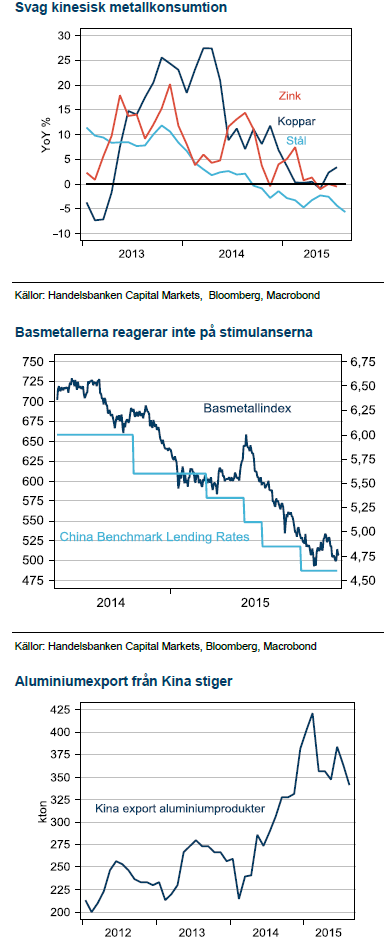 Kinafrossan över för denna gång
Kinafrossan över för denna gång
Kina har sänt chockvågor på de finansiella marknaderna efter devalveringen i augusti som sedan följdes av mer svag makrodata. Den underliggande ekonomin utvecklas svagt och därför kommer regeringen fortsätta föra en balanserat stimulativ politik. Fastighetspriserna har dock stigit under hela 2015 varpå man troligen kommer vara mer försiktig med ytterligare sänkning av räntan. Förutsättningarna för FAI (investeringar) har förbättrats på sistone efter ett brant fall tidigare i år samtidigt som försäljningen av fastigheter tagit fart. Detta kan leda till punktvis ökad efterfrågan på basmetaller under en kortare period (Q4+Q1).
Cyklisk industri
Basmetaller är förmodligen skolexemplet på cyklisk industri med kapitalintensiva anläggningar med lång livstid och starkt cyklisk efterfrågan på produkterna. Därför kommer producenter alltid göra sitt yttersta för att effektivisera och kapa kostnader för att hålla produktionen igång. Under den nuvarande nedgången har producenterna också fått stark medvind från svagare valuta i de flesta gruvländer. Den senaste nedgången i priser stressar producenterna men kanske ännu mer de finansiella institutioner som finansierar dem. Brist på nya lån till bra villkor kan därför bli en faktor som accelererar stängning av dyr produktion.
När kommer stängningarna
Över de senaste 12 månaderna har Kina omvandlats till en exportör av aluminiumprodukter och rostfritt nickellegerat stål tillsammans med råstål som pressar priserna globalt. Kinas inhemska efterfrågan är svag och leder ut överproduktionen på världsmarknaden.
Överproduktion och svag lönsamhet i Väst borde redan ha lett till stängningar av produktion. Nickelgruvor har det värst följt av aluminiumsmältverk. Stål och koppar ligger fortfarande bra till lönsamhetsmässigt. Stål har fått en andhämtning efter lägre priser på insatsråvarorna. Zink ligger någonstans mellan de båda grupperna. USD-producenter har det värst och Kinas produktion av aluminium står i skottgluggen, här har vi sett en del stängningar men det skapas också ny kostnadseffektiv produktion. Nickelgruvor borde vi se komma ur produktion före årsskiftet.
Energi
I Kina är importtrenden starkt stigande sedan oljepriserna började falla och importen växer med omkring 10 % i årstakt. Kinas valutapegg till USD skyddar landets köpkraft, till skillnad från andra utvecklingsekonomier som inte får ta del av det lägre oljepriset på samma vis då deras valuta deprecierats kraftigt.
Höga förväntningarna på Irans återkomst
Sedan Iranavtalet slöts i juli har osäkerheten kring om sanktionerna ska hävas och Irans förmåga att återuppta produktionen till nivåer före sanktionerna successivt lättat. Idag råder en bred konsensus att sanktionerna hävs under första kvartalet 2016 och Iran säger sig därefter kunna öka produktionen med 1 Mbpd. Under det negativa marknadssentimentet tror vi marknaden rusat åstad och prisat in för mycket förväntningar på Iran. Vi ser flera skäl till att Irans olja kommer dröja men därefter komma med oväntad kraft.
Skifferproduktionen minskar
USA:s skifferindustri har visat sig priskänslig. Efter att riggar togs bort från fälten under våren började de återvända från juni sedan oljepriset studsat upp i maj-juni. Efter den senaste prisnedgången minskar åter antalet aktiva riggar. Produktionstrenden i USA var länge intakt trots att riggarna togs bort från fälten. Sedan mitten av juli har dock produktionen fallit snabbt. Dataserien är visserligen estimerad och revideras ofta kraftigt men två månaders fallande produktion talar för att skifferoljan kommer minska under andra halvåret.
Kan elpriset stiga?
Det viktigaste för Nordisk el är utan tvekan vädret och nederbördsenergin i södra Norge och norra Sverige just nu. Efter att kolpriserna ser ut att vara låga under lång tid av strukturella skäl är kol idag en liten del av riskkomponenterna för prisuppgång.
Marknaden prissätter numera inte årskontrakten över kostnaden att använda kolkraft och därför blir de långa terminerna väldigt låga. En kall höst och vinter skulle naturligtvis ändra den bilden dramatiskt. Efter det kalla första kvartalet 2010 och 2011 prissattes en premie för liknande scenario de kommande åren, denna premie har sedan successivt fasats ut under de senaste årens milda vintrar. En kall vinter är alltså det främsta och kanske enda scenario för att rådande svaga pristrend ska brytas och elpriserna vända upp.
Ädelmetaller
Vi har tidigare argumenterat för att Feds supermjuka penningpolitik var den främsta drivkraften till guldprisuppgången efter finanskrisen. Guld föll också kraftigt när Fed började med ”tapering”. Under de senaste veckorna har guld visat sig allt mer känsligt för Amerikansk makrodata som i sin tur har påverkan på Fed:s höja eller inte höja spel. De uteblivna höjningarna har initialt fått guld att stiga men därefter har guldet åter hamnat i sin fallande trend. Vi tror att guldet kommer stanna kvar där fram till första höjningen är avklarad.
Fed börjar för sent
Marknaden var fram till september övertygad om att den första höjningen skulle ske före årsskiftet. Efter den uteblivna höjningen och fortsatta mjuka tongångar från Fed-ledarmöter tillsammans med den svaga arbetsmarknadsrapporten förra veckan får man nu gå fram till juni 2015 för att räntemarknaden ska prisa in en säker första höjning.
Volkswagen skapar palladiumrally
Den tydligaste effekten av skandalen i Tyskland i råvarumarknaden har varit kraftigt stigande priser på palladium. Platina och palladium används i katalysatorer för att rena avgaser och palladium mestadels i bensinbilar medan platina huvudsakligen i dieselbilar. Prisrörelserna speglar marknadens förväntningar på minskad efterfrågan på dieselbilar framgent då den tekniska utvecklingen kan ha gått in i en mer mogen fas som har tvingat producenter till fusk för att klara de ständigt hårdare miljökraven.
Jordbruk
Under Q3 såg vi en oväntat stor volatilitet i jordbruksråvarorna. Den svaga globala makromiljön med stort fokus på de kinadominerade råvarorna spillde över även på jordbruksprodukter med mycket mer stabil efterfrågesida. I ett avseende har dock global marknadsoro en viktig prispressande effekt, genom lägre valutor i flera viktiga producentländer.
Därmed kan flera av de stora producenterna erfara mer attraktiva priser på jordbruksråvaror i USD, varpå exportmarknaden blivit mer attraktiv. Efterfrågan från exportmarknaden har däremot varit medioker då flera av de stora importörerna lider under svag köpkraft med en svag inhemsk valuta.
Konsekvensen av ekvationen har blivit att globala lager av de stora råvarorna soja, majs och vete har fortsatt att stiga och därmed pressa priserna.
Majspriserna på botten?
Majspriset har nått nivåer där lönsamheten ifrågasätts av odlaren och borde finna stöd i produktionskostnaden. Majs har varit extra hårt ansatt då grödan är tätare kopplad till energimarknaden genom användningen i etanolindustrin och därmed det fallande oljepriset.
Ryssland lider av torka
Vetepriserna har stigit som konsekvens av torkan i Ryssland och Ukraina som frestar det höstsådda vetet. Sedan början av september har USA-vetet stigit 10 %, varav en liten del säkert kommer från El Nino-torka i Australien som ska skördas i november-december och därför är känsligt just nu. Torka är alltid viktigt att följa men senaste två åren har torra grödor i Ryssland ändå gett god skörd. Således en riskpremie i priset som kan fall bort eftersom.
USA skördar majs och soja
Skörden av soja och majs i USA är färdig till 21 och 18 % efter att veteskörden är avklarad. Avkastningen på soja verkar så här långt vara väldigt bra medan USDA väntas skruva ned avkastningen något på majs. Det är sannolikt inte allvarligt nog att ligga bakom senaste prisuppgången utan den är nog spunnen ur de högre vetepriserna.
[box]SHB Råvarukommentar är producerat av Handelsbanken och publiceras i samarbete och med tillstånd på Råvarumarknaden.se[/box]
Ansvarsbegränsning
Detta material är producerat av Svenska Handelsbanken AB (publ) i fortsättningen kallad Handelsbanken. De som arbetar med innehållet är inte analytiker och materialet är inte oberoende investeringsanalys. Innehållet är uteslutande avsett för kunder i Sverige. Syftet är att ge en allmän information till Handelsbankens kunder och utgör inte ett personligt investeringsråd eller en personlig rekommendation. Informationen ska inte ensamt utgöra underlag för investeringsbeslut. Kunder bör inhämta råd från sina rådgivare och basera sina investeringsbeslut utifrån egen erfarenhet.
Informationen i materialet kan ändras och också avvika från de åsikter som uttrycks i oberoende investeringsanalyser från Handelsbanken. Informationen grundar sig på allmänt tillgänglig information och är hämtad från källor som bedöms som tillförlitliga, men riktigheten kan inte garanteras och informationen kan vara ofullständig eller nedkortad. Ingen del av förslaget får reproduceras eller distribueras till någon annan person utan att Handelsbanken dessförinnan lämnat sitt skriftliga medgivande. Handelsbanken ansvarar inte för att materialet används på ett sätt som strider mot förbudet mot vidarebefordran eller offentliggörs i strid med bankens regler.
Analys
Tightening fundamentals – bullish inventories from DOE

The latest weekly report from the US DOE showed a substantial drawdown across key petroleum categories, adding more upside potential to the fundamental picture.

Commercial crude inventories (excl. SPR) fell by 5.8 million barrels, bringing total inventories down to 415.1 million barrels. Now sitting 11% below the five-year seasonal norm and placed in the lowest 2015-2022 range (see picture below).
Product inventories also tightened further last week. Gasoline inventories declined by 2.1 million barrels, with reductions seen in both finished gasoline and blending components. Current gasoline levels are about 3% below the five-year average for this time of year.
Among products, the most notable move came in diesel, where inventories dropped by almost 4.1 million barrels, deepening the deficit to around 20% below seasonal norms – continuing to underscore the persistent supply tightness in diesel markets.
The only area of inventory growth was in propane/propylene, which posted a significant 5.1-million-barrel build and now stands 9% above the five-year average.
Total commercial petroleum inventories (crude plus refined products) declined by 4.2 million barrels on the week, reinforcing the overall tightening of US crude and products.


Analys
Bombs to ”ceasefire” in hours – Brent below $70

A classic case of “buy the rumor, sell the news” played out in oil markets, as Brent crude has dropped sharply – down nearly USD 10 per barrel since yesterday evening – following Iran’s retaliatory strike on a U.S. air base in Qatar. The immediate reaction was: “That was it?” The strike followed a carefully calibrated, non-escalatory playbook, avoiding direct threats to energy infrastructure or disruption of shipping through the Strait of Hormuz – thus calming worst-case fears.

After Monday morning’s sharp spike to USD 81.4 per barrel, triggered by the U.S. bombing of Iranian nuclear facilities, oil prices drifted sideways in anticipation of a potential Iranian response. That response came with advance warning and caused limited physical damage. Early this morning, both the U.S. President and Iranian state media announced a ceasefire, effectively placing a lid on the immediate conflict risk – at least for now.
As a result, Brent crude has now fallen by a total of USD 12 from Monday’s peak, currently trading around USD 69 per barrel.
Looking beyond geopolitics, the market will now shift its focus to the upcoming OPEC+ meeting in early July. Saudi Arabia’s decision to increase output earlier this year – despite falling prices – has drawn renewed attention considering recent developments. Some suggest this was a response to U.S. pressure to offset potential Iranian supply losses.
However, consensus is that the move was driven more by internal OPEC+ dynamics. After years of curbing production to support prices, Riyadh had grown frustrated with quota-busting by several members (notably Kazakhstan). With Saudi Arabia cutting up to 2 million barrels per day – roughly 2% of global supply – returns were diminishing, and the risk of losing market share was rising. The production increase is widely seen as an effort to reassert leadership and restore discipline within the group.
That said, the FT recently stated that, the Saudis remain wary of past missteps. In 2018, Riyadh ramped up output at Trump’s request ahead of Iran sanctions, only to see prices collapse when the U.S. granted broad waivers – triggering oversupply. Officials have reportedly made it clear they don’t intend to repeat that mistake.
The recent visit by President Trump to Saudi Arabia, which included agreements on AI, defense, and nuclear cooperation, suggests a broader strategic alignment. This has fueled speculation about a quiet “pump-for-politics” deal behind recent production moves.
Looking ahead, oil prices have now retraced the entire rally sparked by the June 13 Israel–Iran escalation. This retreat provides more political and policy space for both the U.S. and Saudi Arabia. Specifically, it makes it easier for Riyadh to scale back its three recent production hikes of 411,000 barrels each, potentially returning to more moderate increases of 137,000 barrels for August and September.
In short: with no major loss of Iranian supply to the market, OPEC+ – led by Saudi Arabia – no longer needs to compensate for a disruption that hasn’t materialized, especially not to please the U.S. at the cost of its own market strategy. As the Saudis themselves have signaled, they are unlikely to repeat previous mistakes.
Conclusion: With Brent now in the high USD 60s, buying oil looks fundamentally justified. The geopolitical premium has deflated, but tensions between Israel and Iran remain unresolved – and the risk of missteps and renewed escalation still lingers. In fact, even this morning, reports have emerged of renewed missile fire despite the declared “truce.” The path forward may be calmer – but it is far from stable.
Analys
A muted price reaction. Market looks relaxed, but it is still on edge waiting for what Iran will do

Brent crossed the 80-line this morning but quickly fell back assigning limited probability for Iran choosing to close the Strait of Hormuz. Brent traded in a range of USD 70.56 – 79.04/b last week as the market fluctuated between ”Iran wants a deal” and ”US is about to attack Iran”. At the end of the week though, Donald Trump managed to convince markets (and probably also Iran) that he would make a decision within two weeks. I.e. no imminent attack. Previously when when he has talked about ”making a decision within two weeks” he has often ended up doing nothing in the end. The oil market relaxed as a result and the week ended at USD 77.01/b which is just USD 6/b above the year to date average of USD 71/b.

Brent jumped to USD 81.4/b this morning, the highest since mid-January, but then quickly fell back to a current price of USD 78.2/b which is only up 1.5% versus the close on Friday. As such the market is pricing a fairly low probability that Iran will actually close the Strait of Hormuz. Probably because it will hurt Iranian oil exports as well as the global oil market.
It was however all smoke and mirrors. Deception. The US attacked Iran on Saturday. The attack involved 125 warplanes, submarines and surface warships and 14 bunker buster bombs were dropped on Iranian nuclear sites including Fordow, Natanz and Isfahan. In response the Iranian Parliament voted in support of closing the Strait of Hormuz where some 17 mb of crude and products is transported to the global market every day plus significant volumes of LNG. This is however merely an advise to the Supreme leader Ayatollah Ali Khamenei and the Supreme National Security Council which sits with the final and actual decision.
No supply of oil is lost yet. It is about the risk of Iran closing the Strait of Hormuz or not. So far not a single drop of oil supply has been lost to the global market. The price at the moment is all about the assessed risk of loss of supply. Will Iran choose to choke of the Strait of Hormuz or not? That is the big question. It would be painful for US consumers, for Donald Trump’s voter base, for the global economy but also for Iran and its population which relies on oil exports and income from selling oil out of that Strait as well. As such it is not a no-brainer choice for Iran to close the Strait for oil exports. And looking at the il price this morning it is clear that the oil market doesn’t assign a very high probability of it happening. It is however probably well within the capability of Iran to close the Strait off with rockets, mines, air-drones and possibly sea-drones. Just look at how Ukraine has been able to control and damage the Russian Black Sea fleet.
What to do about the highly enriched uranium which has gone missing? While the US and Israel can celebrate their destruction of Iranian nuclear facilities they are also scratching their heads over what to do with the lost Iranian nuclear material. Iran had 408 kg of highly enriched uranium (IAEA). Almost weapons grade. Enough for some 10 nuclear warheads. It seems to have been transported out of Fordow before the attack this weekend.
The market is still on edge. USD 80-something/b seems sensible while we wait. The oil market reaction to this weekend’s events is very muted so far. The market is still on edge awaiting what Iran will do. Because Iran will do something. But what and when? An oil price of 80-something seems like a sensible level until something do happen.
-

 Nyheter4 veckor sedan
Nyheter4 veckor sedanUppgången i oljepriset planade ut under helgen
-

 Nyheter3 veckor sedan
Nyheter3 veckor sedanMahvie Minerals växlar spår – satsar fullt ut på guld
-

 Nyheter4 veckor sedan
Nyheter4 veckor sedanLåga elpriser i sommar – men mellersta Sverige får en ökning
-

 Nyheter2 veckor sedan
Nyheter2 veckor sedanOljan, guldet och marknadens oroande tystnad
-

 Nyheter2 veckor sedan
Nyheter2 veckor sedanJonas Lindvall är tillbaka med ett nytt oljebolag, Perthro, som ska börsnoteras
-

 Analys4 veckor sedan
Analys4 veckor sedanVery relaxed at USD 75/b. Risk barometer will likely fluctuate to higher levels with Brent into the 80ies or higher coming 2-3 weeks
-

 Analys3 veckor sedan
Analys3 veckor sedanA muted price reaction. Market looks relaxed, but it is still on edge waiting for what Iran will do
-

 Nyheter2 veckor sedan
Nyheter2 veckor sedanDomstolen ger klartecken till Lappland Guldprospektering


